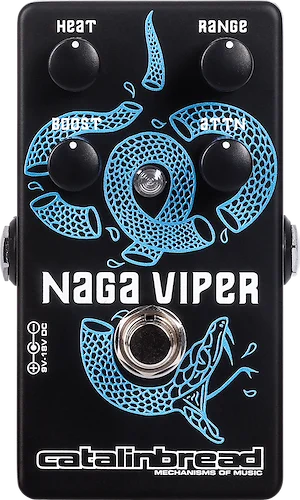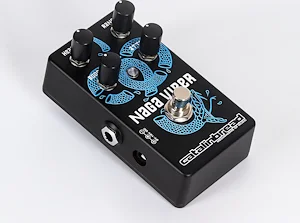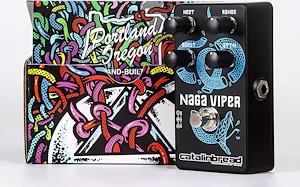Brian May, Eric Clapton, Tony Iommi, and others pioneered the use of the Treble Booster, more specifically the Dallas Rangemaster*. One thing that made this circuit such an anomaly in effects canon was its lack of foot control; the Rangemaster was an amp-top device with a teeny-tiny toggle switch that was an absolute pain to disengage mid-riff. Of course, back in 1966 when it was invented, “pedals” as we know them today didn’t exist yet. For those players, their rig consisted of amp, Rangemaster and guitar.
All of these players found that the Rangemaster really came to life when it fed an already cranked amp, and indeed, the sound of Rangemaster-into-redlined-amp is instantly recognizable to its devotees.
In today’s modern landscape though, things aren’t always nearly that simple. Some players run any combination of effects into their amp, with some players having multiple “always-on” pedals careening into the treble booster. Now equipped with a foot-operated bypass switch, the humble treble booster may still hit a cranked amp but oftentimes it does so with the backing of multiple gain devices feeding it. For some players, this works. For many, this arrangement loses sight of what a treble booster actually does and what it adds to a rig.
The newest version of our Naga Viper fixes this problem by adding an attenuator knob. This control acts like a level control for everything in front of the Naga Viper, letting you shave some heat from the incoming signal before it runs through the proverbial gears of the booster. This leads to less saturation and undesirable effects and more treble-boosting goodness going into your amp.
The transistor in the Naga Viper has also been replaced and the circuit tastefully reworked to accommodate players of all stripes. Some players will leave the Attenuate control all the way up, and this design choice is for them. By swapping out the transistor, the Naga Viper is even hotter than before, with extended ranges for both Heat and Boost controls. Diming both controls now gives a slight edge compared to V1, opening up the range of the attenuator as well.
Though the actual production number of the Rangemaster is unknown, the general consensus is that not many were ever manufactured. While the majority of those released contained the same value for the boost potentiometer, some much rarer versions purportedly contained a different value that is said to make the tone hotter and a touch "gainier". We agree, and our newest version contains that uncommon value to extract a little "more" from this circuit.
None of the legendary Rangemaster players had many controls to work with, so we’ve reconfigured the circuit with that ethos in mind. The knobs on the Naga Viper aren’t there for constant twiddling, just set it up how it works for you once, then leave it alone and play that thang!
*References herein to the "Dallas Rangemaster" and "Rangemaster" refer to the iconic
Rangemaster from the 1960s. Rangemaster® is currently a registered trademark of Sound City Amplification, LLC.
Controls:
HEAT: You can think of this as the Naga Viper’s gain knob. When it’s all the way down, you get that classic treble booster response, that is to say a slightly dirty boost, and rolling this control up intensifies the grit until it’s a drive unit unto itself. At minimum, the stock treble booster profile sounds its best running into an already overdriven amp, but increasing the Heat softens that and adapts the Naga Viper to work better with clean amps.
BOOST: This sets the output level of the Naga Viper. According to ancient pedal texts, the classic Rangemaster design is dependent on a certain value in this position, but a small number of outliers found their way into recording studios with a value that made the circuit “a little hotter.” We have elected to use this rarer value to up the output significantly to give you more from even the most stubborn amps. When turning this knob, it is normal to hear a whooshing sound; the originals also did this, and who are we to stand in the way of tradition?
RANGE: This controls the amount of bass frequencies let into the booster. Historically, the input and output capacitors of the treble booster are tiny, which lets in very few bass frequencies and less overall gain. You can find this setting with the knob maxed. As you roll this control down, more and more bass is let into the circuit and the range is thus increased. With the Range all the way down, you experience a full-frequency booster that also increases the level of gain.
ATTN: Short for attenuate. The treble booster is a simple, straightforward circuit; it boosts what you give it. But because the originals were designed to run as a guitarist’s only effect, they don’t really take other gain devices as well as they could. As such, vital notes of the treble boost’s flavor can be easily lost in modern pedal setups, with some guitarists running one or more “always-on” devices. This control lets you tame the incoming signal down to a lower volume, which gives the circuit a little room to breathe before it does its thing.



